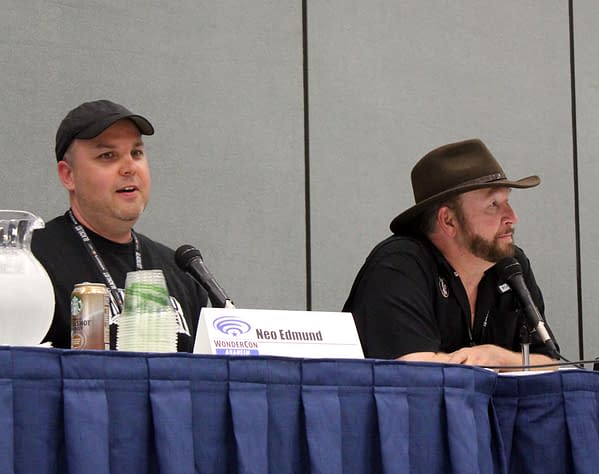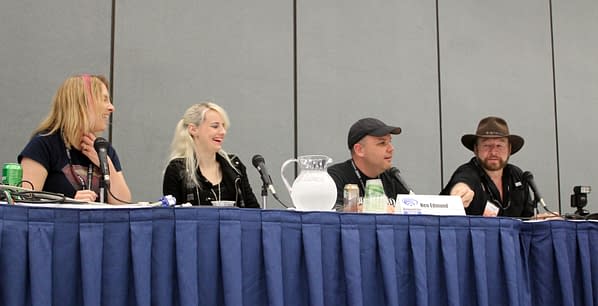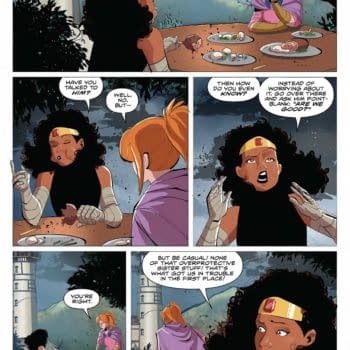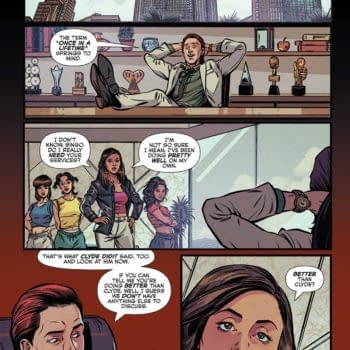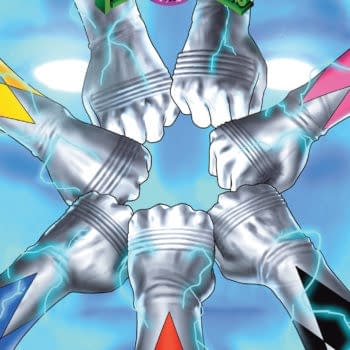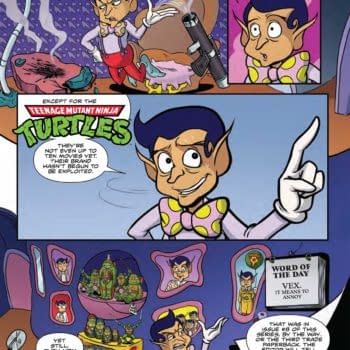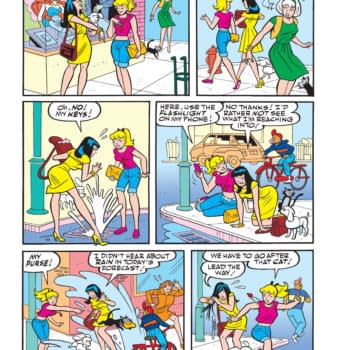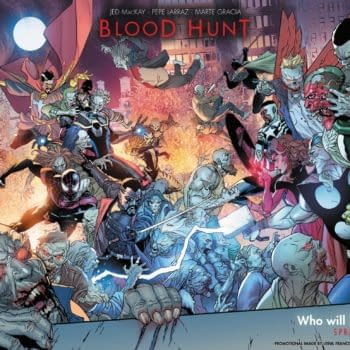Posted in: Comics, Recent Updates | Tagged: black widow, buffy the vampire slayer, Comics, entertainment, female heroes, neo edmund, the avengers, The Matrix, velvet, women in comics, wondercon
Women In Comics Month Finale – Talking With Neo Edmund About Dropping The Cliches
By Michele Brittany, a West Coast Bleeding Cool Correspondent
I have a confession to make: the portrayal of women is not usually at the forefront of my mind when I'm reading comics, graphic novels or watching other popular forms of culture. However, as I prepared for a presentation on Ed Brubaker's Velvet for last month's Comics Arts Conference series at Wondercon, I began to take a closer look at women in the media I was consuming.
With the celebration of Women in Comics this month by Previews, my interest was further piqued when I wanted to prepare my own top ten list of up and coming women in the industry. There were established women – Amanda Connor, Ann Nocenti, Gail Simone – but I failed miserably to gather ten women that I had personally read or experienced their art in the comics and graphic novels I had read. Then a topic over the weekend came up on a scholarly discussion board that gave me further pause: violence against women in comic narratives.
I learned that although women make up anywhere from 40 – 47% of the readership of comics and graphic novels, female authorship (I'm including the entire creative team, i.e. writers, artists, letterers, colorists, inkers, etc.) makes up just over 12% (I reference Tim Hanley's Bleeding Cool Gendercrunching article dated March 28, 2014) of the total creators at DC Comics. Marvel had similar, though lower figures. Seeing these statistics enlightened me on why I came up short on my list, but it also revealed an overarching question: how does an industry acknowledge and challenge acceptable past tropes to create a balanced gender narrative?
Asking that question led me back to panel organizer Neo Edmund. His recent panel Beyond Clichés: Creating Awesome Female Characters for Comics, Film, and Video Games at last month's Wondercon resulted in approximately 200 con attendees packed into a small room (and many more were turned away) for an hour's discussion about women in media. I've been fortunate to attend a similar panel at some of the various cons in which it has been offered, and I reached out to Edmund to talk more about the problematic portrayal of women in comics.
Michele Brittany: Neo thank you so much for your time. I came across your panel at the Long Beach Comic Expo and Horror Con and I thought listening to a panel discuss their challenges enlightening. Can you tell the readers a bit about yourself, your background and how you are involved in the comics industry?
Neo Edmund: I've been working in entertainment for about 10 years. I started as a film and television Development Executive and over time built a career as a writer. I've since written for film, animation, comics, and even put out a novel. For the last two years I've been writing kids and educational comics with a publisher called Silver Dragon Books. We've done titles with many major brands such as Discovery Channel, Animal Planet, JumpStart, History Channel, just to name a few.
MB: Can you tell me what led you to organize Beyond Clichés: Creating Awesome Female Characters for Comics, Film, and Video Games?
NE: Several years ago I was developing an action/adventure animated series with Jim Henson Studios. They loved the project and worked hard to push it forward, but we met unexpected resistance when we went out to the major animation studios. The trouble we encountered is that the project had a female character as the lead action hero. Though everybody loved the concept, the studio execs didn't believe that girls would be interested in watching an action show with a girl in the lead, and they insisted that boys would never, ever watch such a show. Of course we cited the popularity of Power Puff Girls, Kim Possible and Sailor Moon, but at the end of the day we couldn't overcome the resistance and the project never moved forward. In the aftermath, I decided this issue needed to be brought to light, which inspired me to start hosting panels at comic conventions.
MB: When and where did you hold your first the first panel?
NE: Five years ago at the very first Long Beach Comic Con. They put us in a room large enough to seat several hundred people, which would have been great had more than 10 people showed up! Despite the low turnout we pushed forward and had a great talk. I've since hosted the panel every year at LBCC and several other cons, and it almost always fills the room. The fantastic turnout we had at WonderCon this year has opened the door to do the panel at other cons!
MB: I think the panel of experts discussing their challenges with portraying women in their respective mediums revealed that each encounter pretty much the same issues. What do you think are a few of the bigger hurdles with trying to portray (create) female characters that break traditional/expected stereotypes?
NE: In my opinion the stereotypes ARE the biggest hurdle. There was a time when a female character on a show, movie, or comic, had to be the personification of everything that males found cool and interesting. I coined the term the 'overcompensated female character syndrome': she has an IQ of 180, knows seven forms of martial arts, went to MIT where she built a rocket ship at age 14, can play the guitar like Eddie Van Halen, knows all about race car engines, and somehow finds time to maintain the body of a buxom bikini model.
The other part of the problem is that female characters often have to be apologetic for their emotions, and at some point have to screw up and be saved by the male lead. For example, in Lethal Weapon 3, Rene Russo played a female cop that was seemingly the equal of Mel Gibson's character, but during the final shoot out she does something totally out of character, forcing the heroic male to save her. He even calls her stupid for her actions (in the most loving way possible) and she ends up saying sorry and agrees to stop being a cop so they can be together. The real nail in the coffin is that these sort of stereotypical female characters usually end up falling flat and become impossible for an audience to connect with.
MB: I saw statistics that indicated that female authorship of comics is at best 12% and I would think that is also a part of the problem with an industry relying on stereotypes. What stumbling blocks are there for women, as creators, in the industry?
NE: As odd as it may sound, I think 12% is actually a huge improvement (though far from where we should be). If you went back in time just one decade, the number would have been more like 1% (at best). In the world pre-2000, you could probably count the names of every major female comic creator and editor on your fingers. The fact that we're 'up' to 12% means things are changing, and most of that change has been in the last few years.
I don't think it's fair to put all the blame on sexism (though there is no doubt that this is a major issue in comics). The reality is that until recent days comics were a thing consumed almost entirely by teenage boys and young adult men. When I was a teenager, it was a rare event to even see a girl in a comic shop or at a comic convention. This naturally resulted in an industry that was made up almost entirely of men, because the readers became the creators.
A friend recently told me she wish she had discovered comics 10 or 15 years ago. I then told her that such a great realization comes with great responsibility: she must now make sure that young girls won't say the same thing 10 or 15 years from now. Exposing young girls to comics now will surely result in far more female creators in the future.
MB: What are your thoughts of improving those statistics?
NE: I say when they won't let you do something, then find a way to go do it yourself. We are in an era where independent comics are not only possible, but can also be a huge success. Just look at all the indie comics that have been nominated for Eisner Awards this year alone. We all have the power to make our own comics and publish them. A successful independent creator can gain a lot of attention and this can lead to opportunities to work with the bigger companies. If women want to make comics then they should be making comics and not waiting around for permission from anybody. This may not be the quick and easy answer to resolve the issue with the major publishers, but the more that female creators can get noticed, the more willing the publishers and audiences will be to accept them.
I believe in the next 5-10 years the number of female creators working for the major comic publishers will be in the range of 25%, 40%, or even 50%. The reason has to do with the explosion of popularity in comic conventions, cosplay, and the massive success of comic based films. It's safe to say that the number of women attending comic conventions is now equal to the number of men, and the readership of comics is fast approaching 50-50. The more women become interested in comics, the more women will become interested in creating comics, and the harder women will fight for the opportunity to work in this growing industry.
MB: I was reading a discussion board topic about violence against women in our narratives. It shouldn't be a surprise, but the use of rape as a background/plot device for a woman and the resulting action of the hero and/or heroine becomes one of revenge. It seems there has to be a new way to give complexity to both genders. How do we change the narrative and more importantly, how do we as consumers voice that we want new narratives?
NE: I think creators who use rape as an inciting plot device are just being lazy. They're looking for one tragic event that will drive the story forward and few will ever question the motives of the hero who has been raped. As a consumer, our power is in our spending choices. If consumers refuse to buy those comics, they will likely go away. The problem is that publishers might not recognize the offensive themes as the reason for the failure of a title. The good news is that the internet has given us an even greater power, and that is the power to make our voices heard. If you don't like something write blogs, post on your social media pages, create memes, and tag the publishers in your tweets. They are paying attention and eventually they will wise up, or be pushed out of business.
MB: What are a few examples of female characters that get it right and should be followed or emulated?
NE: (This is a pretty broad subject, so I'll limit my answer to characters within the comics and action genres). The unfortunate reality is that there aren't nearly enough. Two of the very best were Ripley in Aliens and Sarah Connor in Terminator 2. James Cameron created two characters that were as tough as nails, but at the same time he allowed them to have moments that showed genuine emotions, and never made them apologize for it. This being said, nobody is better at building great female characters than Joss Whedon. His work on Buffy the Vampire Slayer showed the world that females can be strong, can kick butt, and still retain their femininity, and he never made them say sorry. Joss Whedon was once asked why he keeps writing strong female characters, and he simply responded by saying "because you're still asking me that question." I believe that without Joss' work on Buffy and Angel, characters like Trinity in The Matrix and Katniss Everdeen would have never made it to the big screen, nor would there be talk of a standalone film featuring Black Widow from the Avengers.
MB: When you hold your panel, what are three facets of creating female characters that you want attendees of your panel to take away with them?
NE: First and foremost, put all the stereotypes of gender aside and focus on building characters that are as true and as real as possible. Second, don't fall into the trap of overcompensating a female character's abilities, because having an implausible set of skills is not what makes a human being strong. Avoid clichés such as the girl who knows all about muscle cars because her dad or her boyfriend taught her. It's 2014 and if a girl wants to know about cars she can choose to take auto shop and build her own car in her own garage. Finally, and most importantly, tell your story in a way where the female characters never, ever, ever have to say sorry for being strong females.
MB: Where can the readers catch your next Beyond Clichés panel? And who have you invited as your panel experts?
NE: I'm hoping I'll get to do this at San Diego Comic Con, but the verdict is still out. I will be hosting the panel at Long Beach Comic Con in September and likely a few other cons along the way. If anybody wants to see this panel at San Diego or any other comic con, please tell the programming directors of the cons, or just send them a Tweet. As for panelist, I try to change that up every time to keep the discussion fresh. My ultimate fanboy fantasy would be to get Joss Whedon to participate. One can dream, right!
MB: Is there anything you would like to add before we close?
NE: Thanks so much for giving me this opportunity to get the word out about this very important subject. I hope some day an article of this nature will be unnecessary, but until we get there… ONWARD AND UPWARD!!!
Neo Edmund will have a booth at the Long Beach Comic Expo this weekend at the Long Beach Convention Center.
All photographs were taken by Michele Brittany at Edmund's Beyond Clichés panel at Wondercon this past April.
Michele Brittany is an independent popular culture scholar and semi-professional photographer currently editing an upcoming anthology on the influence of James Bond on popular culture. She regularly posts reviews and analysis on the spy/espionage genre on her blog, Spyfi & Superspies.





